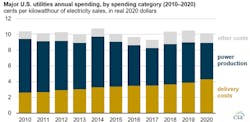This is why microgrids are becoming popular: Jigar Shah
Jigar Shah, a well-known energy entrepreneur who now serves as director of the Department of Energy’s (DOE) loan programs, posted on LinkedIn last week: “This is why #microgrids and #distributedgeneration are becoming so popular.”
Shah was referring to a US Energy Information Administration (EIA) graphic that shows power production costs falling and delivery prices rising over the last decade. In other words, if you’re wondering why your power bill went up, look to the grid of transmission and distribution wires, not the power plants, solar and wind farms, and hydroelectric facilities that make the energy.
The EIA found that the cost of delivering power was 65% higher in 2020 than 2010. Meanwhile, utility spending on power production fell from 6.8 cents/kWh in 2010 (using 2020 dollars) to 4.6 cents/kWh in 2020.
How to bypass the delivery system
Because microgrids produce power on-site, or at least near the site they serve, they don’t require the 700,000 circuit miles of transmission lines and millions of miles of distribution lines used to move power around in the US.
The cost of building, operating and maintaining the lines isn’t the only thing microgrids can bypass. Another is line loss, the amount of power inserted into the grid at point A that never makes it to point B. The DOE estimates line loss at about 5%. How much power is that? The Natural Resource Defense Council says it’s enough to power all seven Central American countries four times. That’s money that disappears into the ether when we send electricity long distances, something microgrids have no need to do.
The financial benefit of avoiding delivery costs stack on top of other benefits microgrids and on-site energy offer, most notably the electric reliability provided when the transmission and distribution system fails, such as during hurricanes and wild fires.
Join us for the world’s largest gathering of microgrid experts and leaders at Microgrid 2022, June 1-2 in Philadelphia.
All this isn’t to say that microgrids don’t use the grid. Most in the US do, at least when it’s to their host’s advantage to do so. When it’s not — say at times of day when grid prices are higher than the cost to use on-site generators — the microgrid can disconnect from the grid and rely on its own energy sources to save money.
Going completely off grid
Sometimes microgrid owners don’t bother ever connecting to the grid. Usually, these “remote” microgrids are on islands or other places far from the grid. But not always. We’re beginning to see microgrid owners in places like California and New York City choosing not to connect at all to save money and avoid the hassle of the interconnection approval process.
The past doesn’t always foretell the future and predicting energy prices is a tricky business. So we can’t say for sure that this financial edge for microgrids will continue forever — that power delivery costs will rise as generation costs fall.
Questioning the status quo
But we do know that strong lobbying is underway to pour more money into the electric delivery system. To be fair, there are good reasons for this. The US transmission and distribution grid is old and needs upgrades. On top of that, the US needs more transmission wire to move energy from large-scale wind and solar farms to population centers and to accommodate electric vehicles.
But how much wire does it actually need? Where can microgrids and on-site energy offer “non-wires alternatives” that are less expensive? Where can they serve electric vehicles, avert grid congestion, replace aging equipment, accommodate renewable energy — and do this while improving electric reliability for a business, organization or community? And are public utilities commissions asking these questions enough?
Track news about microgrids. Subscribe to the free Microgrid Knowledge Newsletter.
About the Author
Elisa Wood
Editor-in-Chief
Elisa Wood is the editor and founder of EnergyChangemakers.com. She is co-founder and former editor of Microgrid Knowledge.
